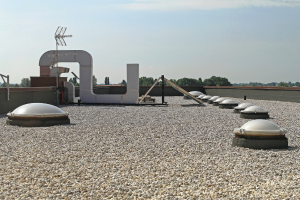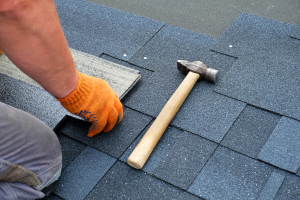Whether you own a home or commercial property, the onset of spring means a to-do list full of landscaping and tidying your outdoor spaces. This year, don’t forget to add regular roof maintenance and a spring roof inspection to your list. Spring is the best time for roof repair and maintenance, as the snow, ice, and wind of winter takes a toll on your roof, and you want to make sure it’s ready to keep you dry during summer storms. Read on for our best spring roof maintenance tips and what to expect in your spring inspection.
Spring Roof Maintenance Tips For Commercial Flat Roofs
Staying on top of repairs and routine upkeep is essential to maintain the health of your commercial roof. Your regular commercial roof maintenance should include the following:
Clean the gutter systems. Harsh winter weather can fill your gutter system with leaves, tree limbs, moss, and garbage. A blocked drainage system leads to overflows and structural damage, so it’s vital to clean it out each spring. Additionally, loose sections of the gutter should be re-secured, and damaged sections should be replaced right away.
- Inspect after storms. Hail, high winds, and heavy rainfall can quickly cause roof damage. Stay a step ahead of the damage by performing a visual inspection of the roof after every severe storm.
- Trim trees. Keep trees growing close to your building trimmed to help prevent branches from falling onto the roof during storms.
- Schedule a commercial roof inspection. Have a thorough inspection done by a roofing professional. A commercial roof inspection should include checking scuppers, drains, penetrations, HVAC unit doors, and edge metal.
- Repair cracks, tears, and leaks. Make repairs to damaged portions of the roof as soon as they are discovered to prevent them from causing even greater damage to your building.
Spring Roof Maintenance Tips For Residential Roofs
Similarly, all homeowners should perform routine roof maintenance to keep their home’s roof in top condition. Your residential roof maintenance plan should include the following:
Clean out gutters. Have gutters and downspouts cleared of debris left by winter storms. Check for cracks, holes, and leaks in your guttering and replace damaged sections as soon as possible.
- Check for mold. As moisture collects on your roof during the winter, it is common for mold or moss to grow. If you do find patches of mold or moss, contact a roofing professional for removal.
- Trim trees. If you have tree branches overhanging your roof, make sure to trim them back. Staying on top of this detail can help prevent storm-related damage to your roof.
- Schedule a residential roof inspection. Have a professional trusted contractor check your roof for loose shingles, proper flashing, high nails, and potential leaks in valleys or penetrations. Scheduling a regular residential roof inspection can catch minor damage before it becomes a bigger problem.
- Make necessary repairs. If damage is found, have repairs done right away. This will keep major roofing issues at bay and reduce your long-term maintenance costs.
Benefits of Regular Roof Maintenance and a Spring Roof Inspection
Performing routine roof maintenance and scheduling regular inspections provides a wealth of benefits:
Maintain roof integrity. Staying up to date on roof maintenance and inspections helps keep your roof in its best possible condition, ensuring it continues to protect your property for many years.
- Catch problems early on. Find potential leaks before they start, identify damage caused by winter and early spring weather, and make repairs before they become bigger issues.
- Protect your health. Roof leaks can create the ideal conditions for mold and mildew growth. As you likely know, mold and mildew can cause or exacerbate respiratory issues. Routine roof maintenance and inspections can help protect the health of you and your employees or family.
- Save money. When you catch potential problems early, you can prevent some bigger roof repairs and costly interior damage, and even push roof replacements further into the future. It also gives you the opportunity to budget for big repairs or replacements early on, buying you time to save up for them.
- Put your mind at ease. Ensuring your roof is in top condition will give you peace of mind through spring and summer rainstorms.
What You Can Expect From a Spring Roof Inspection
When you hire a professional roofing specialist to perform an inspection, you can expect them to thoroughly check your roof for damage and potentially vulnerable areas. They will clean scuppers and drains on flat roofs and check all flashings on RTUs, HVAC and pipes. Once your inspection is complete, your roofer should provide you with photos of the inspection, a list of potential leaks, and a quote for repair costs. From there, you can work with your roofing specialist to schedule a time for any needed repairs.
 Clean the gutter systems. Harsh winter weather can fill your gutter system with leaves, tree limbs, moss, and garbage. A blocked drainage system leads to overflows and structural damage, so it’s vital to clean it out each spring. Additionally, loose sections of the gutter should be re-secured, and damaged sections should be replaced right away.
Clean the gutter systems. Harsh winter weather can fill your gutter system with leaves, tree limbs, moss, and garbage. A blocked drainage system leads to overflows and structural damage, so it’s vital to clean it out each spring. Additionally, loose sections of the gutter should be re-secured, and damaged sections should be replaced right away. Clean out gutters. Have gutters and downspouts cleared of debris left by winter storms. Check for cracks, holes, and leaks in your guttering and replace damaged sections as soon as possible.
Clean out gutters. Have gutters and downspouts cleared of debris left by winter storms. Check for cracks, holes, and leaks in your guttering and replace damaged sections as soon as possible. Maintain roof integrity. Staying up to date on
Maintain roof integrity. Staying up to date on 